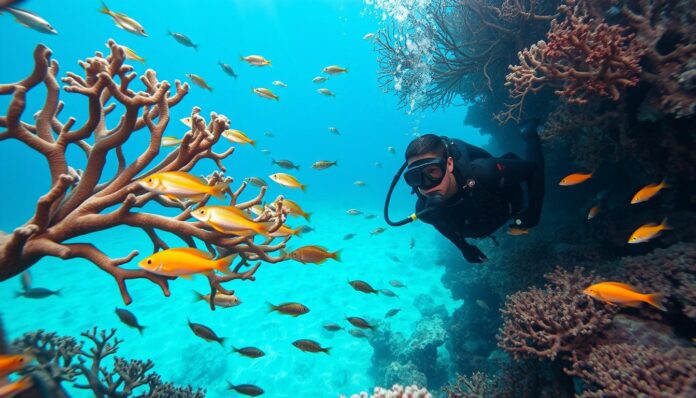Imagine seeing a fish that can grow up to 7.5 feet long and weigh over 400 pounds. The Napoleon wrasse is a huge creature found in tropical seas. It offers scuba divers an amazing chance to explore the underwater world.
Scuba diving with wrasses lets you see a colorful world under the sea. These fish swim through coral reefs. It’s a chance to see their natural behavior. For those who love taking pictures underwater, wrasses are a dream to capture.
From the clear waters of the South Pacific to the Indian Ocean, diving with wrasses is a unique adventure. These fish are not just big and long-lived. They also help keep coral reefs healthy.
Key Takeaways – Diving with Wrasses
- Napoleon wrasses can grow up to 7.5 feet in length
- Wrasses inhabit tropical marine environments worldwide
- Underwater photography offers unique glimpses into wrasse behavior
- Scuba diving provides direct encounters with these fascinating fish
- Wrasses are essential to coral reef ecosystem health
Introduction to Wrasses in the Marine Ecosystem
Diving into the vibrant world of coral reefs shows us a fascinating group of fish. Wrasses are colorful and dynamic, adding spectacular diversity to underwater ecosystems.
Wrasses are a remarkable family of marine fish known for their adaptability and unique traits. They live in tropical and subtropical waters, playing a key role in marine biodiversity.
What are Wrasses?
Wrasses are small to medium-sized fish with distinctive features. They have elongated, compressed bodies, vibrant color patterns, and can change sex during their lifetime.
Importance of Wrasses in Coral Reefs
These fish are vital to the health of marine ecosystems. During marine life encounters, divers see wrasses performing essential ecological functions.
| Wrasse Species | Size Range | Ecological Role |
|---|---|---|
| Cortez Rainbow Wrasse | 4-13 cm | Reef cleaning, predator control |
| Ballan Wrasse | 30-50 cm | Parasite removal, ecosystem balance |
| Cuckoo Wrasse | Up to 60 cm | Invertebrate population management |
“Wrasses are not just fish, they are underwater guardians maintaining the delicate balance of coral reef ecosystems.” – Marine Biologist
Wrasses eat parasites, small crustaceans, and invertebrates, keeping coral reefs healthy. Their symbiotic relationships with other marine species make them essential to underwater biodiversity.
The Joy of Scuba Diving with Wrasses
Diving into the vibrant underwater world of tropical dive sites opens up a mesmerizing realm. Wrasses become the stars of snorkeling adventures here. These colorful fish offer divers an extraordinary opportunity to witness marine life in its most intimate form.
Encountering wrasses up close reveals their fascinating personalities and unique behaviors. These marine creatures are known for their incredible curiosity and interactive nature. They often approach divers with surprising confidence.
Engaging with Wrasses Underwater
During tropical dive sites exploration, divers can experience several remarkable interactions with wrasses:
- Watching cleaning stations where wrasses remove parasites from larger fish
- Observing their mating rituals
- Witnessing their playful swimming patterns
Unique Behaviors of Wrasses
Wrasses demonstrate remarkable intelligence and adaptability in their marine environment. Their ability to change sex is fascinating. Some species can transition from female to male depending on social dynamics within their ecosystem.
“Every dive with wrasses is like watching a live underwater documentary,” says marine biologist Dr. Elena Rodriguez.
Some extraordinary wrasse behaviors include:
- Smashing sea urchins against rocks while feeding
- Creating complex social hierarchies
- Performing complex communication through color changes
For enthusiasts seeking unforgettable snorkeling adventures, wrasses represent an incredible underwater experience. It combines scientific wonder with pure marine magic.
Finding Wrasses: Best Dive Locations
Finding the right place to see wrasses needs careful planning and knowledge of the ocean. PADI certifications help divers learn to explore these amazing places. They also support eco-tourism.
Premier Global Diving Destinations for Wrasse Encounters
For an unforgettable wrasse experience, check out these top spots:
- Raja Ampat, Indonesia: This place in the Coral Triangle has incredible marine life.
- Palau: Dive here all year for amazing wrasse sightings.
- Galapagos Islands, Ecuador: A UNESCO World Heritage Site with unique sea life.
- Roatán, Honduras: Home to over 500 fish species in beautiful reefs.
Other Notable Wrasses Diving Locations
Asia:
- Maldives: The Maldives offers an abundance of vibrant coral reefs teeming with wrasses. Dive sites such as Maaya Thila and Fish Head are known for their diverse marine life, including various wrasse species.
- Indonesia: Indonesia boasts incredible dive locations, including Raja Ampat, Komodo National Park, and Bali. These areas are home to a wide range of wrasses, along with other colorful marine species.
- Philippines: The Philippines is renowned for its exceptional marine biodiversity. Diving in places like Tubbataha Reefs Natural Park, Apo Island, and Moalboal provides opportunities to encounter an array of wrasses in their natural habitats.
- Red Sea (Egypt): The Red Sea offers excellent diving opportunities, with its clear waters and vibrant reefs. Popular dive sites like Ras Mohammed and Brothers Islands are known for their wrasse populations, alongside other mesmerizing marine life.
- Seychelles: The Seychelles archipelago is a paradise for divers, with its pristine coral reefs. Explore dive sites like Aldabra Atoll and the Marine National Park of Sainte Anne to encounter an array of wrasses and other fascinating marine species.
- Bonaire: Bonaire, part of the Dutch Caribbean, is a world-class diving destination. The island’s protected marine parks, such as Bonaire National Marine Park, offer opportunities to dive alongside various wrasses and explore colorful reefs.
- Cayman Islands: The Cayman Islands, particularly Grand Cayman, are renowned for their outstanding diving. Explore dive sites like the North Wall and Bloody Bay Marine Park in Little Cayman to witness the beauty of wrasses and the diverse Caribbean marine life.
- Belize: Belize is home to the Belize Barrier Reef, a UNESCO World Heritage site. Dive locations like the Great Blue Hole and Glover’s Reef Atoll provide opportunities to encounter wrasses, alongside vibrant coral formations and diverse marine ecosystems.
- Costa Rica: The Pacific coast of Costa Rica offers fantastic diving experiences. Locations such as Cocos Island and Isla del Caño are known for their rich biodiversity, including wrasses, sharks, and other pelagic species.
- Red Sea (Egypt): While geographically located in Africa, the Red Sea is easily accessible from Europe. Dive centers in countries like Egypt offer convenient access to the Red Sea’s vibrant reefs and diverse wrasse populations.
- Canary Islands (Spain): The Canary Islands, off the coast of Spain, provide excellent diving opportunities. Dive sites like El Hierro and Lanzarote offer encounters with wrasses and other fascinating marine species amidst volcanic landscapes.
- Great Barrier Reef (Australia): The Great Barrier Reef is a world-renowned diving destination. Locations such as the Ribbon Reefs and Cod Hole are known for their spectacular biodiversity, including various wrasse species.
- Fiji: Fiji’s crystal-clear waters and thriving coral reefs make it a top choice for diving enthusiasts. Explore dive sites like the Somosomo Strait and Beqa Lagoon to discover wrasses and a multitude of other colorful marine creatures.
- Hawaii (United States): The Hawaiian Islands offer diverse diving experiences. Explore locations like Molokini Crater and the Big Island’s Kona Coast to encounter an array of wrasses and explore vibrant reef systems.
- Florida Keys (United States): The Florida Keys provide access to the only living coral barrier reef in North America. Dive sites such as Looe Key and Sombrero Reef offer opportunities to dive alongside wrasses and explore the diverse marine ecosystems.
- Galápagos Islands (Ecuador): The Galápagos Islands are a unique and biodiverse diving destination. Encounters with wrasses, along with iconic species like marine iguanas and sea lions, await divers exploring sites like Wolf and Darwin Islands.
- Fernando de Noronha (Brazil): Fernando de Noronha, a protected archipelago off the coast of Brazil, is known for its pristine marine environments. Divers can encounter wrasses and explore the rich underwater ecosystems surrounding the islands.
These destinations offer incredible opportunities to dive with wrasses and explore the breathtaking beauty of their marine habitats. Remember to adhere to local regulations, dive responsibly, and respect the fragile underwater ecosystems to ensure their preservation for future generations.
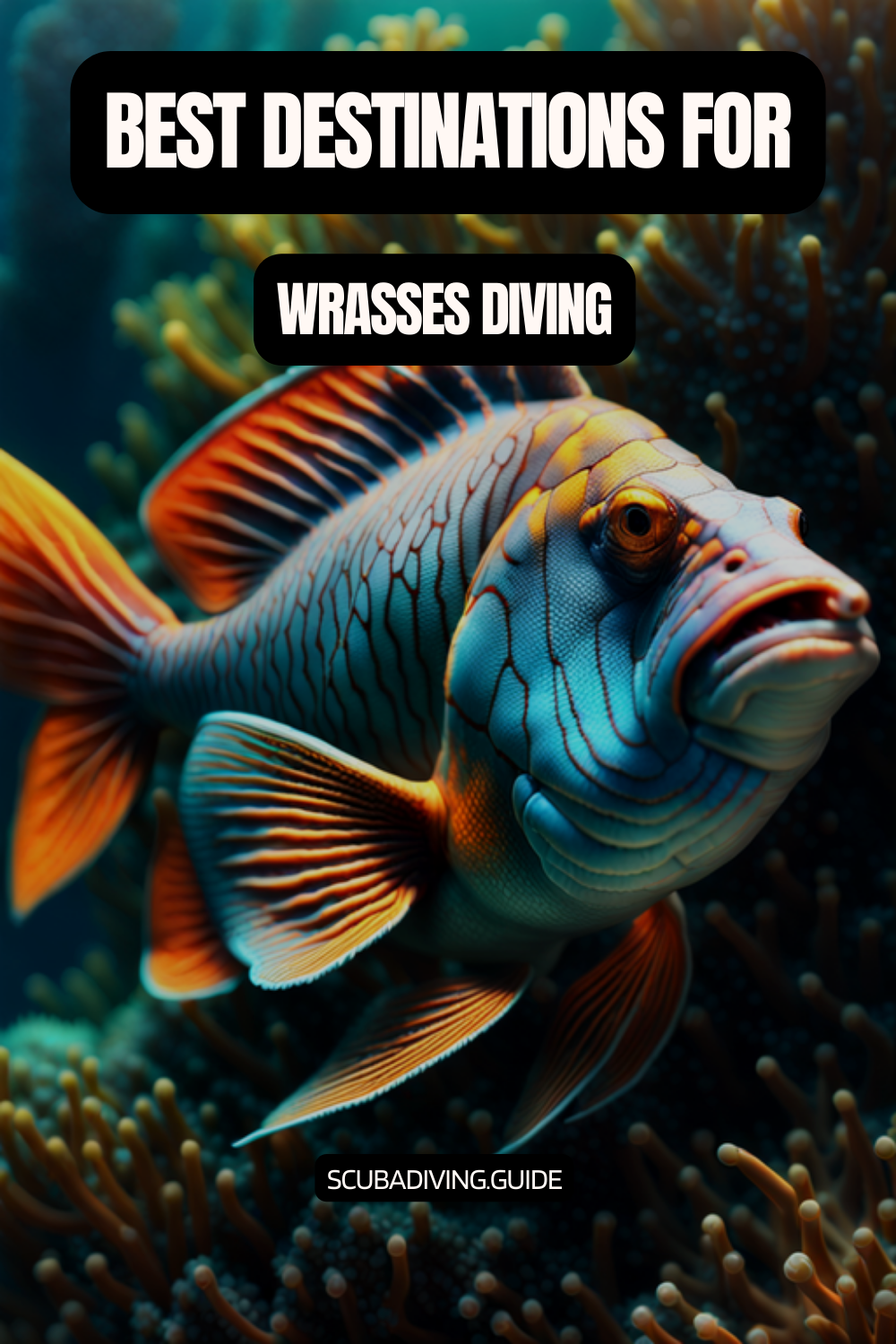
Seasonal Wrasse Sighting Patterns
Knowing when to dive is key for spotting wrasses. Each place has its best times to see them.
| Location | Best Diving Season | Water Temperature |
|---|---|---|
| Palau | October – May | 81-84°F (27-29°C) |
| Galapagos Islands | December – May (Warm Season) | 60-86°F (16-30°C) |
| Raja Ampat | October – April | 79-84°F (26-29°C) |
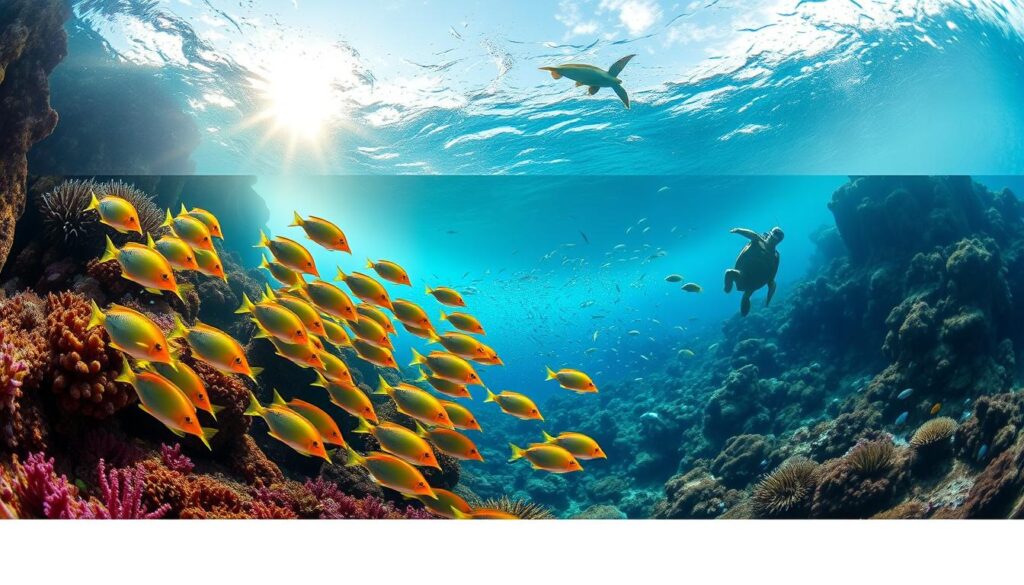
“The ocean is a vast classroom for understanding marine life, and wrasses are its most fascinating students.” – Marine Biologist
Eco-tourism means diving responsibly. Divers should protect the sea, reduce harm, and respect these special places.
Scuba Diving Preparation and Gear
Getting ready for a scuba diving trip with wrasses needs careful planning and the right gear. Whether you’re new to diving or have lots of experience, knowing the basics is key. It makes your dive better and keeps you safe while you explore wrasses’ world.
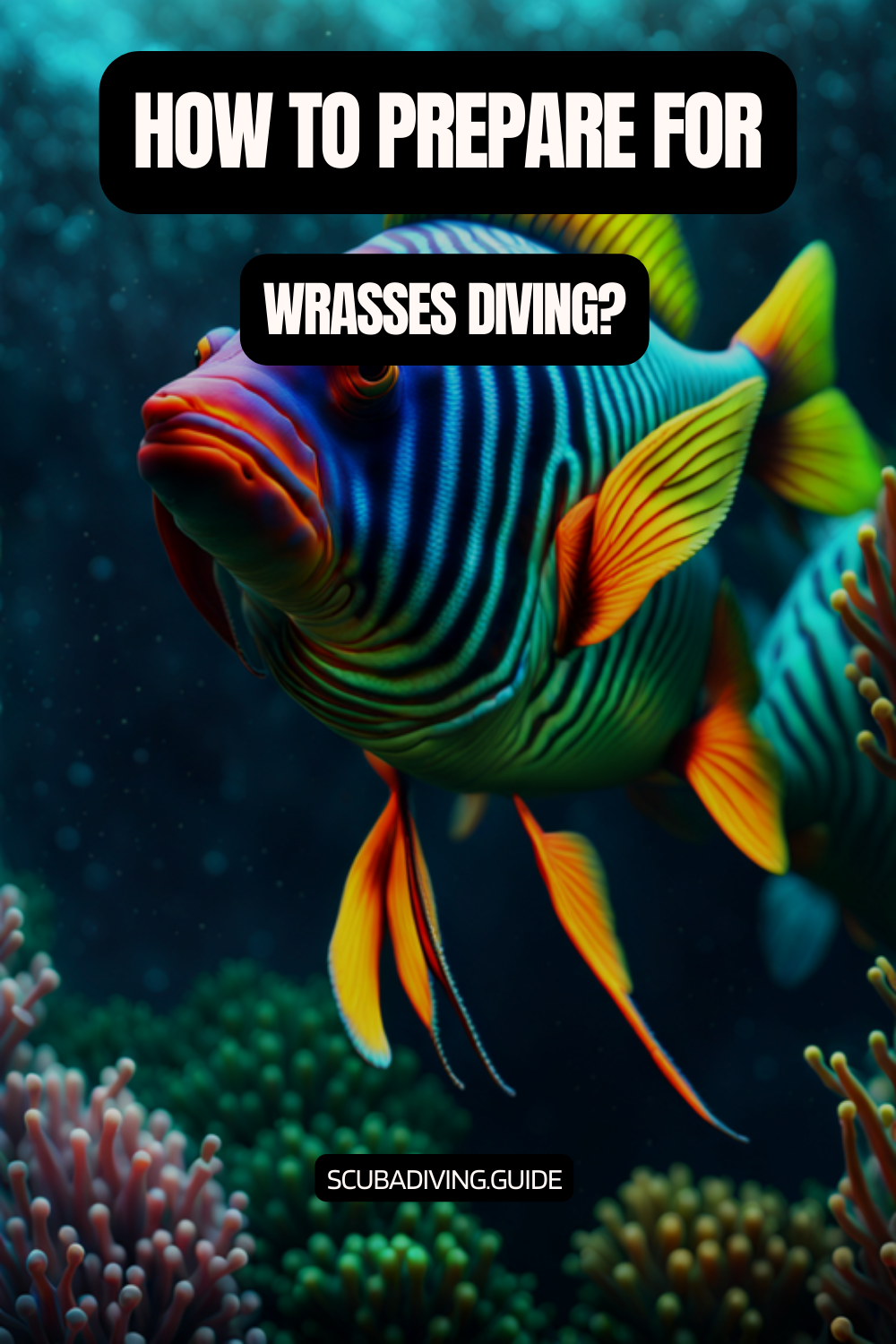
Essential Scuba Equipment for Wrasse Observation
Choosing the right gear is important for diving with wrasses. Here’s what you need:
- Mask with anti-fog coating for clear underwater visibility
- Wetsuit appropriate for water temperature
- Buoyancy Control Device (BCD)
- Regulator with backup air source
- Dive computer for tracking depth and time
- Underwater camera for capturing wrasse interactions
Safety Precautions for Responsible Diving
PADI certifications are key for diver safety and protecting marine life. Before diving with wrasses, remember these safety tips:
- Complete a PADI Open Water Diver certification
- Practice proper buoyancy control to avoid damaging coral reefs
- Maintain a safe distance from marine life
- Check equipment thoroughly before each dive
- Always dive with a buddy
“Respect the ocean, and it will reveal its most incredible secrets.” – Marine Biologist
By following these steps and getting PADI certifications, you’re set for a safe and fun dive with wrasses. Remember, diving responsibly protects the ocean and makes your dive better.
Underwater Photography Tips for Wrasses
Capturing the vibrant world of wrasses through underwater photography needs skill, patience, and special techniques. Marine life encounters with these dynamic fish offer unique challenges for photographers. They aim to document the fascinating behaviors of these fish.
Underwater photography requires precise technical knowledge and a careful approach. The right camera settings can turn an ordinary marine life encounter into an extraordinary visual story.
Best Practices for Capturing Wrasses
- Maintain a respectful distance to avoid disturbing marine habitats
- Use a macro lens for detailed close-up shots
- Practice smooth, controlled buoyancy underwater
- Anticipate wrasse movement and behavior patterns
Ideal Camera Settings Underwater
Choosing the perfect camera setup is key for stunning underwater photos. Professional photographers suggest specific settings to capture wrasses in their natural habitat.
| Camera Setting | Recommended Range | Purpose |
|---|---|---|
| Aperture | f/4 to f/7.1 | Shallow depth of field |
| Shutter Speed | 1/250 seconds | Freeze fish movement |
| ISO | 160-320 | Balanced light sensitivity |
Pro tip: A 105 mm macro lens allows greater distance from wrasses, minimizing disturbance during marine life encounters.
“Patience and technical precision are the keys to extraordinary underwater photography.” – Marine Photography Expert
Capturing wrasses requires understanding their unique behaviors and causing minimal underwater disruption. By mastering these techniques, photographers can create compelling visual stories of these remarkable marine creatures.
Understanding Wrasse Species
Diving into the world of wrasse fish shows us a vibrant marine life. It’s key to exploring coral reefs. These creatures are part of a dynamic fish family in our oceans.
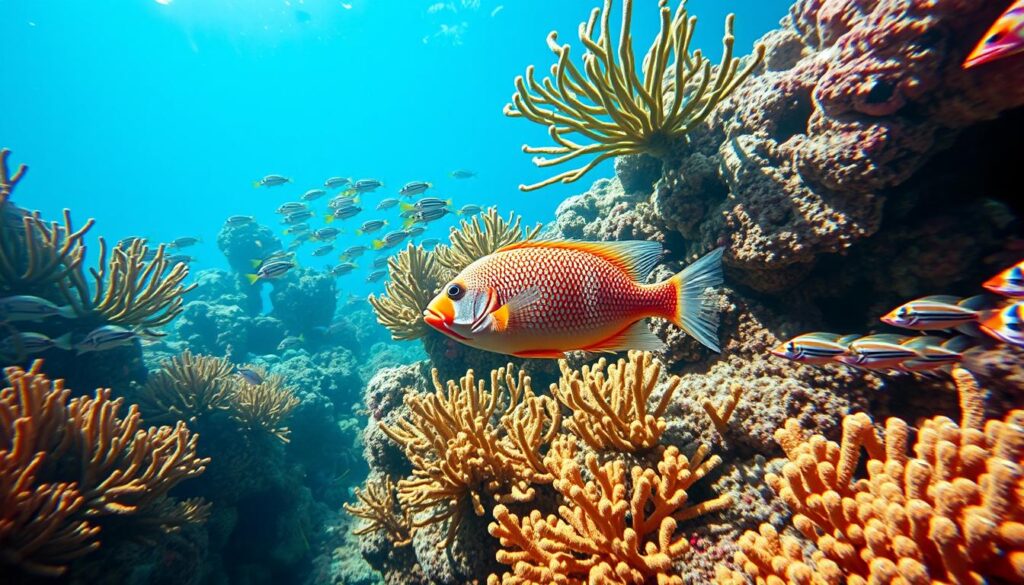
The wrasse family has over 600 unique species. They live in different marine places. Their ability to adapt makes them important in coral reef ecosystems.
Popular Wrasse Species to Encounter
When divers explore coral reefs, they see many wrasse species:
- Napoleon Wrasse (Cheilinus undulatus): The largest wrasse species
- Cleaner Wrasse: Known for symbiotic cleaning behaviors
- Rainbow Wrasse: Vibrant colors and dynamic patterns
- Humphead Wrasse: Distinctive large forehead
Distinguishing Male and Female Wrasses
Wrasse fish show interesting differences between males and females. Color variations, size differences, and fin structures help us tell them apart. This is during coral reef exploration.
“The underwater world of wrasses is a testament to nature’s incredible diversity and complexity.” – Marine Biologist Research Team
Some key differences include:
- Males have more intense colors
- Mature males are larger
- Special fin structures
- Behavioral changes during mating
Knowing these details makes diving better. It helps us appreciate these amazing sea creatures more.
Eco-Friendly Diving Practices
Diving with wrasses lets us explore marine life and help conservation. It’s important to dive responsibly to protect our oceans. This helps keep marine habitats safe.
When we dive, we must be careful to protect marine life. We can help by following some simple rules:
- Maintain a safe distance from marine organisms
- Avoid touching or disturbing coral reefs
- Use reef-safe sunscreen
- Minimize underwater movement to prevent sediment disruption
- Participate in local marine conservation programs
The Importance of Conservation
Palau is home to amazing marine life, with over 1,500 fish and 700 coral species. Eco-tourism strategies help keep these ecosystems healthy.
“Every dive is an opportunity to become a steward of marine conservation.” – Marine Biologist Research Team
Respectful Interaction with Marine Life
Knowing how marine life behaves helps us dive without harming the environment. We should:
- Observe marine creatures without disturbing them
- Use underwater communication techniques
- Support local conservation efforts
- Document our dives in a way that doesn’t harm the sea
| Conservation Practice | Impact |
|---|---|
| Reef-Safe Practices | Protects coral ecosystems |
| Responsible Photography | Minimizes marine life disturbance |
| Supporting Local Programs | Enhances marine habitat preservation |
By diving responsibly, we help protect our oceans. We get to see amazing creatures like wrasses up close.
The Science of Diving with Wrasses
Exploring the underwater world shows us amazing things about marine life and coral reefs. Wrasses are a key group of fish that help keep our oceans diverse.
Scientists have learned a lot about wrasse behavior and their role in the ocean. With over 800 species around the world, these fish are very adaptable and complex.
Behavioral Studies of Wrasses
Research on wrasses has found interesting things about their social lives and how they communicate. Some key findings are:
- They can change gender during their lives
- They have complex social lives in reefs
- They have smart ways to find food
“Wrasses are not just fish, they are key players in the ocean’s balance.” – Marine Biology Research Institute
Role in Ecosystem Health
Studies show how important wrasses are for coral reefs. They help keep the reef healthy in many ways, like:
- Keeping parasites under control
- Cleaning other sea creatures
- Managing invertebrate populations
| Wrasse Characteristic | Ecological Impact |
|---|---|
| Size Range | 4-39 inches |
| Diet Composition | 70% Carnivorous |
| Reef Species Diversity | Up to 30 species per dive site |
Learning about wrasses helps us understand how to protect our oceans. Divers can help by sharing their experiences and supporting research that protects these amazing fish.
Tips for a Memorable Diving Experience
Scuba diving with Wrasses is an amazing underwater adventure. It needs careful planning and a mindful approach. The ocean’s world is full of challenges and amazing sights for those who dive to explore.
To make the most of snorkeling, use smart techniques. These help you have better underwater experiences and stay safe.
Enhancing Your Underwater Adventure
- Practice advanced buoyancy control to minimize environmental impact
- Develop keen observation skills for tracking wrasse behaviors
- Maintain slow, deliberate movements to avoid startling marine life
Communicating with Dive Buddies
Good underwater communication is key when diving with Wrasses. Divers should learn important hand signals. These help share cool marine life finds.
| Hand Signal | Meaning |
|---|---|
| Pointed finger | Indicate specific marine species |
| Circular motion | Large fish or interesting marine formation |
| Thumb up/down | Check buddy’s status and comfort level |
*”The ocean is a classroom, and every dive is a lesson in marine life interaction.”*
Learning about Napoleon Wrasse behavior can make your dive unforgettable. These interesting fish are most active in the morning. This is the best time to see them. With careful watching and respect, divers can make lasting memories in the ocean.
Wrasses and Their Diet
Diving into the world of wrasse fish reveals a fascinating ecosystem of marine nutrition. These remarkable creatures play a key role in coral reef exploration. They show unique feeding behaviors that support the delicate balance of underwater environments.
Wrasses have an incredibly diverse diet. This makes them essential players in coral reef ecosystems. Their feeding habits are truly remarkable:
- Consuming small invertebrates
- Hunting parasites on other fish
- Grazing on sea urchins and mollusks
- Feeding on zooplankton
Dietary Diversity of Wrasse Fish
With about 500 species in the Labridae family, wrasses show amazing dietary flexibility. Some specialized wrasses act as “cleaning stations”. They remove parasites from larger fish, which is vital for reef health.
“Wrasses are nature’s underwater janitors, keeping marine ecosystems clean and balanced.”
Impact on Coral Reef Ecosystems
The feeding mechanisms of wrasses are truly unique. Their pharyngeal jaws allow them to crush hard-shelled prey. This helps control populations of potentially destructive marine organisms.
By consuming parasitic snails and small crustaceans, wrasses greatly contribute to coral reef health. Understanding these incredible fish gives divers a deeper appreciation for the life beneath the waves during coral reef exploration.
Wrasses: Myths and Facts
Diving into tropical dive sites reveals fascinating truths about wrasses. These vibrant marine creatures are far more complex than most divers initially understand. The humphead wrasse, for instance, can grow up to an impressive 90 inches long and weigh up to 421 pounds. This challenges the belief that wrasses are always small fish.
Common Misconceptions About Wrasses
Marine life encounters often surprise divers with the unique characteristics of wrasses. Many believe these fish are uniform in appearance. But species like the Eclipse-spot Razor Wrasse show remarkable diversity.
This species has a pale jade green body and distinctive black and white ellipsoid marking. It proves that wrasses are anything but ordinary inhabitants of coral reef ecosystems.
Fascinating Facts About These Fish
The world of wrasses is filled with intriguing biological wonders. Some species, like the humphead wrasse, can live up to 32 years. They reach sexual maturity between 5-7 years of age.
Their conservation status tells a critical story. Previously listed as “Vulnerable,” they are now classified as “Endangered” by the IUCN. This highlights the urgent need for protection in marine environments across the Indo-Pacific region.
Common Marine Species Found Alongside Wrasses
When diving with wrasses, you can expect to encounter a diverse array of marine species that share the same vibrant and dynamic reef environments. These species contribute to the richness and biodiversity of the underwater world, creating a captivating ecosystem where wrasses thrive. Let’s explore some of the common marine species often found alongside wrasses:
- Clownfish (Family: Pomacentridae): Clownfish, with their bright colors and playful behavior, are frequently spotted alongside wrasses. They form symbiotic relationships with anemones, finding refuge and protection within their stinging tentacles. Observing the interaction between clownfish and their host anemones is a delight, as they dart in and out, creating a harmonious coexistence.
- Butterflyfish (Family: Chaetodontidae): Butterflyfish are known for their vibrant colors and graceful swimming. They often share the same reef habitats as wrasses, feeding on small invertebrates and algae. The intricate patterns and elegant movements of butterflyfish complement the vibrant wrasses, adding to the visual spectacle of the underwater world.
- Parrotfish (Family: Scaridae): Parrotfish, with their distinct beak-like mouths and vibrant colors, are frequent companions of wrasses on the reef. These herbivorous fish play a vital role in maintaining the health of coral reefs by grazing on algae and helping control its growth. Witnessing their unique feeding behaviors and the vivid hues they display is a fascinating sight.
- Surgeonfish (Family: Acanthuridae): Surgeonfish, also known as tangs, are commonly found in the same reef environments as wrasses. Their vibrant colors and blade-like spines on their tails give them a distinctive appearance. Surgeonfish graze on algae and often form schools, creating mesmerizing underwater displays as they move together in synchronized motion.
- Moray Eels (Family: Muraenidae): Wrasses and moray eels often share symbiotic relationships on the reef. Cleaner wrasses may establish cleaning stations on or near the eels, where they remove parasites and dead skin from the eels’ bodies. This mutually beneficial interaction is intriguing to observe, as the wrasses fearlessly swim around the eel’s open mouth, providing their cleaning services.
- Triggerfish (Family: Balistidae): Triggerfish, with their unique body shape and vibrant colors, are frequently encountered alongside wrasses. They are known for their territorial behavior and may display aggression if approached too closely to their nesting sites. Observing the intricate courtship displays and witnessing the colorful patterns of triggerfish is a thrilling experience.
- Snappers (Family: Lutjanidae): Snappers are common inhabitants of reef environments and can often be seen alongside wrasses. These predatory fish display impressive hunting techniques and may form large schools, providing a sense of awe as they move in unison. Their sleek bodies and sharp teeth make them formidable and captivating subjects for underwater observation.
- Damselfish (Family: Pomacentridae): Damselfish are small, colorful fish commonly found on reefs alongside wrasses. They are known for their territorial behavior and are often seen darting in and out of coral heads or defending their nests. Their vibrant colors and intricate patterns add to the visual diversity and beauty of the underwater ecosystem.
Encountering these diverse marine species alongside wrasses provides a deeper appreciation for the interconnectedness of life within the coral reef ecosystem. Each species contributes to the balance and vitality of the underwater world, forming a tapestry of vibrant colors, unique behaviors, and fascinating ecological interactions.
FAQ – Diving with Wrasses
What are wrasses, and why are they important in coral reef ecosystems?
Wrasses are colorful fish found in warm waters. They help keep coral reefs healthy. They clean other fish by removing parasites, keeping the reef balanced.
Where are the best locations for diving with wrasses?
Great places to dive with wrasses include the Great Barrier Reef in Australia and Palau. The Caribbean, Red Sea, and Indo-Pacific areas are also good. Each spot offers a chance to see different wrasse species.
Do I need special certification to dive with wrasses?
You don’t need a special wrasse diving certification. But, a PADI Open Water Certification is recommended. Advanced certifications help you explore reefs better.
What equipment do I need for underwater wrasse photography?
You’ll need an underwater camera with macro capabilities and a wide-angle lens. Also, an underwater housing, strobes or lights, and a macro port are essential. Compact cameras with underwater settings work well too.
How can I responsibly interact with wrasses during a dive?
Dive eco-friendly by keeping a safe distance and not touching the fish. Control your buoyancy and never feed marine life. Always observe responsibly and conserve.
What makes wrasses unique among reef fish?
Wrasses stand out with their bright colors and cleaning behaviors. They can change gender and have interesting social structures. They play key roles in reef health.
Are wrasses dangerous to divers?
No, wrasses are not dangerous to divers. They are curious and may approach but don’t pose a threat. Some species, like cleaner wrasses, have symbiotic relationships.
How can I improve my chances of seeing wrasses while diving?
Dive at known wrasse sites, during the best times (early morning or late afternoon). Move slowly and quietly. Dive with experienced local guides for the best spots.
What do wrasses eat?
Wrasses eat small invertebrates, crustaceans, mollusks, and parasites. Some are specialized cleaners, while others hunt small prey in coral reefs.
How can divers contribute to wrasse conservation?
Support marine conservation by diving responsibly and participating in citizen science projects. Support marine protected areas and spread awareness about coral reefs and their inhabitants.
